The Final Solution
 |
| Hermann Goering's memo to Reinhard Heydrich mandating the Holocaust. "Endlösung der Judenfrage" in the lowest line translates as "Final solution to the Jewish question." |
The Holocaust is such a huge subject that it is impossible to do it justice in any kind of reasonable space. Every one of the six million victims and many more had a story, and each such story is as important as anyone else's. No matter what is put here, it will never be enough. A few camps attained, shall we say, "celebrity" or perhaps "notoriety" for lack of better words, such as Auschwitz. However, there are many others, such as Sobibor or Maly Trostinets, where countless people died without much notice. Most of those poor souls are barely even remembered except by students of the war. However, it is important that at least some of the camps received enough focus to become household names because they became symbols for all the others.
Let me caution: this page is not for the squeamish.
As the saying goes, never let the perfect be the enemy of the good. While this page can't do justice to such a massive enterprise, a little analysis is better than nothing. Hopefully, this page will stimulate a little thought and remembrance. I get a little deeper into individual camps elsewhere, such as my discussion of Mauthausen, the most brutal concentration camp, but this article will not go into that kind of detail. Instead, it will simply serve as an overview of the machinery of death so that we have a moment to honor the victims.
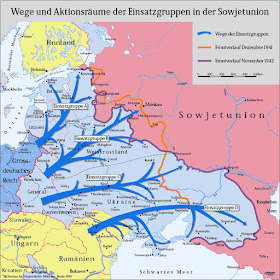 |
| The paths of the four main Einsatzgruppen operations during Operation Barbarossa, the invasion of the Soviet Union. |
The Holocaust did not just "happen," like dropping your phone on concrete or getting in a car accident. It was meticulously planned by the best brains in the German administration. It was not just death camps for "undesirables"; the Germans actively sent out teams to hunt down people they didn't want around and liquidate them. The SS would assemble the "undesirable" people of some little nothing village in the middle of nowhere, march them out to a nearby field, have them dig a hole, shoot them in it, then bury them there. That's a lot different than just having a jail and throwing people in it for a reason, however valid or not. The soldiers at the front would move forward, pushing the enemy back, and the Einsatzgruppen eventually would move in silently behind them.
 |
| This is not all of the concentration camps - but it shows the main ones in Germany and Poland. The Germans held all of this territory through the end of 1944. |
It is important to remember these events. They happened. Remembrance, after all, is what we are after. As a brutal crime against humanity, the Holocaust will live in infamy as long as any other crime by the Axis Powers or anything else done during the 20th Century.
Background
 |
| Adolf Hitler authorized and inspired the Holocaust. |
The Germans rose to power by appealing to the baser instincts of certain elements of the German population. Deep resentment against successful Jews which had lingered for centuries became intertwined with red-hot anger about the loss of World War I and the peace terms imposed in the Treaty of Versailles (which, in retrospect, were not all that harsh). Hitler managed to combine those two strains of resentment to create an edifice of overwhelming hate, a feeling that "others" were trying to ruin Germany. That the Jews really had nothing to do with the outcome of World War I or the terms of the subsequent peace was irrelevant to Hitler. He just manipulated the fierce emotions toward both targets and managed to fuse them to ignite fanatical devotion in his followers.
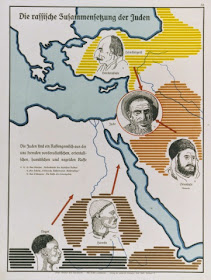 |
| Eugenics poster entitled "The Racial Composition of Jews." The German text reads: "The Jews are a mixture of alien Near Eastern, Oriental, Hamite, and Negroid races." This poster is no.55 in a series entitled, Erblehre und Rassenkunde (Theory of Inheritance and Racial Hygiene), published by the Verlag für Nationale Literatur (Publisher for National Literature), Stuttgart. |
Discrimination against and murder of Jews had been building for years in Germany when Hermann Goering set forth in a July 1941 memo that there be implemented a "final solution" of the "Jewish question." The order was to his principal deputy, Reinhard Heydrich, who was a back-office type who got things done. The memo is reproduced at the top of this article. This instruction led in due course to Heydrich chairing the so-called Wannsee Conference (named after the Berlin suburb where it was held) in January 1942.
 |
| A picture from an Einsatzgruppen soldier’s personal album, labeled on the back as “Last Jew of Vinnytsia.” A member of Einsatzgruppe D is about to shoot a Jewish man kneeling before a filled mass grave in Vinnytsia, Ukraine, in 1941. |
The Wannsee Conference was a major link in the chain of the Holocaust, but the systematic extermination of Jews was already underway with the Einsatzgruppen (German for "task forces", "deployment groups," singular Einsatzgruppe; official full name Einsatzgruppen der Sicherheitspolizei und des SD). The Wannsee Conference just began the systematization of the killings, making them more efficient, quicker, and easier for the authorities. This, in turn, enabled the paramilitary Schutzstaffel (SS), who ran the process, to kill more and more people with less and less effort.
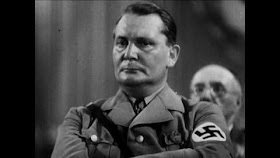 |
| Hermann Goering ordered the Holocaust. |
There's no point going over the numbers of this or that. The number 6 million was invented, and it works, but the actual figure was likely much higher. It wasn't just Jews, but it was primarily Jews, so we use "Jews" in an inclusive sense to represent all victims.
 |
| Heinrich Himmler inspected the camps personally - the only top government official who did - to make sure it was being done right. |
This is a pictorial history, and the numbers are cold and lifeless and stupid individually because they are too large to grasp. There was an awful lot of people who perished, more than in your town or city or county.
 |
| Canister of cyclon B gas used in gas the chambers. It was a cyanide-based pesticide developed in the 1920s. The British executed one of its inventors, chemist, and businessman Bruno Tesch, in 1946 for his participation in the Holocaust. Zyklon B was used in late 1941 to kill Soviet prisoners of war, then adapted for use in the Holocaust in 1942. It was used to kill about a million people. It leaves behind a distinctive light blue ("Prussian blue") residue which can still be seen in concentration camps where it was used to kill people. |
Imagine everyone you ever knew or even saw being slaughtered, and that would barely scratch the surface. Lots of victims, too many for you to ever appreciate any more than you can appreciate the number of grains of sand on a beach.
 |
| Reinhard Heydrich organized the Holocaust. Part of it ultimately was named after him internally as a sort of testimonial, "Operation Reinhard" (German: Aktion Reinhard). |
Entire libraries have been written on this topic. We are not trying to re-write them. We are trying to present something manageable. Rather than just inundate this page with repetitive pictures - because there are endless pictures of dead and dying people, of killers and sadists, of heroes and villains - we'll just try to give a few representative pictures on each salient point and let them serve as an appropriate marker.
Prologue: Boycott and Ostracization - "Jews Are Our Misfortune"
The Holocaust
per se did not begin until the Wannsee conference in January 1942. However, there was absolutely no question where things were headed from the very beginning after the Germans took over. They worked assiduously to separate and dehumanize and destroy the image of Jews from the very start.
The process was not in the slightest bit subtle.
 |
| A billboard in France advertising an exhibition about Jews. |
Some would say the Holocaust actually began earlier than the 1942 Wannsee Conference, and it is difficult to disagree. That was a major turning point, so it always needs to be highlighted. But skipping over the earlier steps that got the government - and public - to the Wannsee Conference would be a major downplaying of the vicious route that German society took along the way.
 |
| An anti-Semitic photomontage entitled, "The Scourge of God, Polish Jews." It was used as a title page for a brochure issued by Der Stürmer. This image was presented as evidence at the Nuremberg trials. |
The dehumanization of the Jews took many forms: books, film, billboards, even parades.
 |
| Public displays of antisemitism in Germany took a variety of forms, from posters and newspapers to films and radio addresses. This float in the Fastnacht (Shrove Tuesday) parade in Singen am Hohentwiel features workers from the local aluminum cylinder works feeding "Jews," wearing paper noses, to the Judenfresser, or "Jew Devourer," a voracious crocodile with big, pointy teeth. The motto carried by the workers' unit in the parade (not shown) was: "Grumblers and Trouble-Makers go under the Roller." |
Kristallnacht ("Crystal Night") was a pogrom (a series of coordinated attacks) against Jews throughout Germany and Austria on 9–10 November 1938.
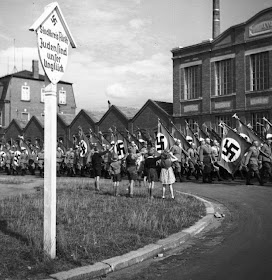 |
| The casual and blatant nature of anti-Semitism in Germany just continually astonishes. This is a picture from around the time of Kristallnacht, showing a marching column at the border between Nürnberg (Nuremberg)-Fürth probably 1938. At the right is the building Höfener Straße 91 in Nürnberg. On the street sign (translated literally) is: "City borough of Fürth / Jews are our misfortune." In the middle, children make the Hitler salute ("Hitlergruß"). Also seen (Höfener Str. 91) is a factory building of J.W.Spear (the building was still in existence recently) -- this Jewish business company was "Aryanised" in 1938. |
It was carried out by SA paramilitary forces, the SS, the Gestapo, and non-Jewish civilians. It earned the name because of the huge amount of storefront plate glass broken - very expensive glass that was a Belgian monopoly.
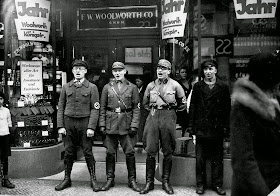 |
| SA men singing to encourage a boycott of F.W. Woolworth in Germany, 1933. |
Hermann Goering, the administrator of the Four-Year Plan, was furious - he was going to have to come up with an awful lot of hard currency to replace all that broken plate glass.
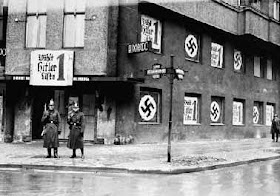 |
| Police maintain watch outside the "Eldorado" nightclub, long frequented by Berlin's homosexual community. The government quickly closed the establishment down and pasted pro-Hitler election posters on the building. Berlin, Germany, March 5, 1933. Landesarchiv Berlin /UNITED STATES HOLOCAUST MEMORIAL MUSEUM #74554. |
Some would say the Holocaust began on Kristallnacht. Any particular date is arbitrary and subject to dispute, 1933 is a good date as well.
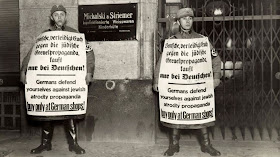 |
| A boycott of Jewish businesses, 1933, the year Hitler took over. The Germans wanted to be crystal clear to everyone, thus the weird translation into English for some reason. Oh, the store behind them? It is selling ready-made white children's hats, probably for school or something along those lines. |
Kristallnacht was a disaster on multiple levels for the Jews. Ostensibly a retaliation against the Jewish community as a whole for the murder of a German diplomat by a Jew, Kristallnacht, in fact, was Propaganda Minister Josef Goebbels' idea derived from his own personal motivations and using the murder entirely as a pretext.
 |
| Germany. Burning Synagogue in Bielefeld during Kristallnacht, 10/11/1938. |
Goebbels wanted to look good to the Fuhrer because of his own scandalous infidelities (his wife reportedly was cheating on him, too), so he set up the pogrom with the SS and the Gestapo as a kind of
bravura act. That's how these folks thought, the ruination of millions of people was nothing if it improved their own position in Hitler's court. Reinhard Heydrich, the Gestapo chief, as usual, was the sinister go-to man when this sort of dirty work was required. A reported 35 people died that night, as did the German soul.
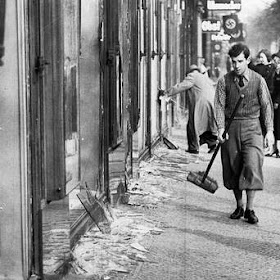 |
| Kristallnacht - cleaning up the next morning. |
Ultimately, Kristallnacht backfired on Germany on many levels. The Jewish shopkeepers generally rented their stores and sold on consignment, with non-Jews the ones left holding the financial bag from all the destruction. Everything was insured, so the loss fell on the German insurance industry - also owned largely by non-Jews. Goering stepped in and, to avoid the financial hit to the economy, passed laws fining the entire Jewish community for the diplomat's murder and outlawing them from the economy. It was a crude and huge step down in the spiral toward the Holocaust.
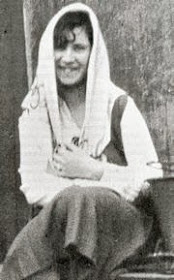 |
| Etty Hillesum was a Dutch Jewish woman who wrote about beauty and meaning and forgiveness. She died in a concentration camp in 1943. |
1. Herding the Victims
In a sense, this is the most horrifying aspect of the Holocaust. The Germans and their helpers and enablers went out and rounded people up, as though the victims were little nothings. It was no different than an animal control officer rounding up feral cats or stray dogs. The profound hatred displayed is stupefying.
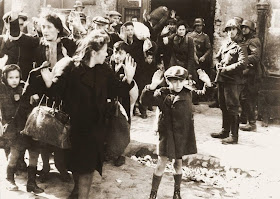 |
| Jews being rounded up in the Warsaw Ghetto. |
 |
| A random street sweep of Jews, Warsaw 1941. |
 |
| German police assigned to controlling open-air markets investigate a Jewish woman, Lublin, Poland, May 1941. They had every right under Nacht und Nebel to just take her in and send her to a camp, without notice to her family or anyone, for any reason they felt sufficient. One wonders what she did that caught their eye - was her shopping bag too full? Maybe just a routine sweep? (Withgen, Federal Archives). |
 |
| Measuring the victims was how they thought they could identify Jewish people. Of course, this was absolute nonsense, but they believed in this method. |
2. Child Victims
Age was no barrier to execution. Anyone could be killed for any reason or no reason. If there was a system, it devolved to killing the oldest and the youngest first, because they would be less useful in the factories and the quarries.
 |
| A 14-year-old Auschwitz victim, Czestawa Kowka, in 1942 or 1943. |
 |
| Children awaiting their fate. |
3. Selection
At some point, the incoming people went before a man sitting at a desk, usually with uniformed SS and perhaps Dobermans behind him. He looked directly into the inmate's eyes - a cold, lifeless stare devoid of humanity or emotion - and then nodded either right or left. One direction led to the barracks. The other direction led to the gas chambers, disguised as showers.
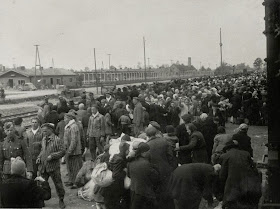 |
| Jews await selection - life or death, though they don't know it - at Auschwitz Birkenau. |
4. Humiliation
Part of the sadistic glee with which the captors exercised their power was derived from the humiliation they could inflict on people they identified with various past humiliations against themselves or people they knew. Foreign occupation of the Rhineland under the Treaty of Versailles? A global Jewish stab-in-the-back plot to rob good Aryans of their dignity. Perhaps they lost their savings or homes in the hyperinflation of the 1920s - blame the Jewish bankers. Or, maybe their family business went under or their stocks tanked during the recent Great Depression - those darned Jews who control finance. Lost their job, lost a court case before a Jewish judge, saw a Jewish child do better at school than theirs, saw them dress differently, observed them buy more stylish clothes or not eat what they ate - there is an unlimited supply of fuel for hatred if you want to blame others who are different for your own misfortune.
You hear the same kinds of things today about the bankers and the media and Hollywood. In truth, the German Jews had been disliked and disparaged by the majority non-Jews since the Middle Ages. It was no great leap for Hitler to channel the underlying public hatred that he himself felt and focus it, increasing the intensity like a laser beam. There was no equivalency between what Jews ever did to the Germans and what they did to the Jews under their control, of course, except in the twisted minds of the low-life sadists given unlimited power over others. Public displays of pointless humiliation reveal what was really at work.
 |
| Rabbi Moshe Hegerman being abused by amused guards, Olkusz, Poland, July 31, 1940. Shoes have been removed, now he's undressing. Note the line of dead beside him. He's being readied to take his place, but not in his normal clothes. |
 |
| Klooga, Estonia: cutting of the beard and sidelocks of Jews in captured territory. The quality of some of the most telling photos is poor, they were often found by chance on the persons of dead Germans, kept as mementos. |
 |
| Women shorn of their hair prior to execution. Human hair has a variety of uses. They wouldn't need theirs any longer. |
5. Starvation
Starvation was the norm. Very, very few concentration camp inmates got sufficient food. During the last days of the war, rations became especially rare and inmates either died of starvation outright or perished from diseases that ravaged impaired immune systems. Many of the pictures of skeleton-like inmates were taken right after the liberation, following a period when rations were especially scarce. Many survivors died of their treatment well after the liberation, nothing could be done to return them to health and sometimes even the return to normalcy happened too quickly for their systems to handle.

Russian prisoners of war were treated horribly right from the start because the Soviet Union was not a signatory to the Geneva Convention, which provided for the humane treatment of prisoners. So many millions of Soviet prisoners died from maltreatment that it is not out-of-line to consider them part of the Holocaust, though technically they are not included. Naturally, they were not given much food. The commandant of Stalag 318, Colonel Falkenberg, noted on September 11, 1941:
These cursed Untermenschen [sub-humans] have been observed eating grass, flowers and raw potatoes. Once they can’t find anything edible in the camp they turn to cannibalism.
Hermann Goering saw or heard of this report, found it insanely amusing, and liked to repeat it at dinner parties with certain embellishments - he said something along the lines of, "The poor devils are so hungry they eat anything, including grass, but more seriously, they have eaten a German sentry!"
Children were not exempt from starvation, they were in the same area as everyone else.
 |
| Two World War II prisoners of war stare through a barbed wire fence at Buchenwald Concentration Camp near Weimar, Germany in 1945. Privation, of course, went well beyond starvation and included prisoners dressed in rags in winter, unheated and overcrowded barracks and the like. Go past the fence by accident or design and you immediately were shot, of course. These fellows could have been taken from professional jobs where they wore suits and ties, or perhaps they were farmers, or maybe even former Wehrmacht soldiers who crossed the wrong person in the hierarchy - didn't matter. Prisoners were prisoners. |
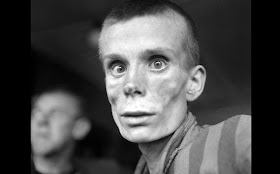 |
| This is an 18-year-old Russian girl, starved beyond recognition. |
6. Expropriation
The Jews, like anyone else, had many useful pieces of property. Part of the death camp process was removing anything useful from them either before their death or while gathering up and disposing of the remains. Some victims would be marked on the face before they entered the gas chambers ("showers") to indicate if they had gold teeth. That made extraction afterward easier.
Expropriation went far, far beyond simply taking whatever was on their person. It also involved dissolving and taking over their businesses, stealing their valuables such as money, stock and art, and taking over their land and homes. However, taking what was on their person - their artificial limbs, their gold teeth, their eyeglasses - was the crudest and most devastating part of the process, and often to little purpose. There are rooms-full at some of the former concentration camps of what was taken off the prisoners' persons, such as eyeglasses and suitcases.
 |
| The Germans hid stolen artwork all over Europe, some of it still missing. Much was hidden in salt mines in Bavaria and Austria because it was easy to pull trains full of loot into them - they generally had train tracks. Here, General Eisenhower goes down in the mines to take a look. This is an educated guess because my source doesn't identify these folks, but that looks like Generals Omar Bradley and George Patton behind Ike - Bradley was Eisenhower's deputy, Patton led the 3rd Army in Southern Germany. Patton - if that is him - looks a bit dumbfounded. In fact, so do all three. |
Many of the valuable items such as paintings appropriated from Jewish victims were never found after the war and remain in private hands, handed down in some fashion from the people who stole them originally. Caches of them are found regularly and restitution of some sort made either to the victims themselves or to the families of the deceased.
7. Working. Them. To. Death.
There are so many good quotes about how the Germans saw the Jews as helping the Third Reich against their will, it is difficult to pick out the best ones. Let's let Heinrich Himmler (Posen speech) speak for them. Himmler is speaking in terms of nationalities, but everyone knew what he really meant when he spoke about 'our own blood':
 |
| In Janowska concentration camp the Germans conducted their tortures, beatings and shootings to the accompaniment of music. For this purpose the SS organised a prisoner's orchestra led by the renowned conductors Stricts and Mund. It was used to cover the noise of the tortures and executions with so called “Death Tango”. Shortly before the camp was liquidated, the Germans shot all the members of the orchestra. |
One basic principle must be the absolute rule for the SS men: We must be honest, decent, loyal and comradely to members of our own blood and to nobody else. What happens to a Russian, to a Czech, does not interest me in the slightest. What other nations can offer in the way of good blood of our type, we will take, if necessary, by kidnapping their children and raising them here with us. Whether nations live in prosperity or starve to death interests me only so far as we need them as slaves for our culture; otherwise, it is of no interest to me. Whether 10,000 Russian females fall down from exhaustion while digging an antitank ditch interests me only insofar as the anti-tank ditch for Germany is finished.
That just about sums up the entire Hitler philosophy. It also happens to be a key reason why they lost the war, but I get into that elsewhere.
So, in essence, it was a matter of supreme indifference what happened to the Jews, as long as German production goals were met. However, those goals could only be met by forcing the Jews to work until they perished, and killing them outright if the work did not kill them. The labor could involve anything from forced carrying of rocks up hills to no purpose until everyone carrying them was dead, or relatively gentle work in subterranean missile factories.
 |
| Slave labor at Mauthausen-Gusen Concentration Camp (1938 - 1945) in Austria. Unlike many other concentration camps, which were intended for all categories of prisoners, Mauthausen was mostly used for extermination through the labor of the intelligentsia. These were educated and members of the higher social classes in countries subjugated by the regime. Hot day, cold day - didn't matter. Out they went to haul rocks. |
 |
| Women's Slave Labor at Ravensbruck Concentration Camp. |
 |
| Women prisoners at work in the shoe repair workshop of Ravensbruck. Holocaust Research Project. These were the lucky ones. |
8. Disposal
Disposal was the fundamental constraint upon extermination. Early in the process, the SS didn't know what to do with all the bodies. You could only dig so many mass graves - that was hard work! The institution of ovens made the whole thing a lot easier.
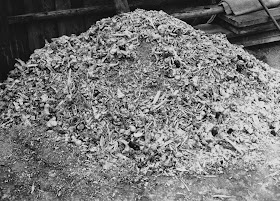 |
| The result of one day of killing in Buchenwald, April 25, 1945. The ovens were fired until the camps were liberated. |
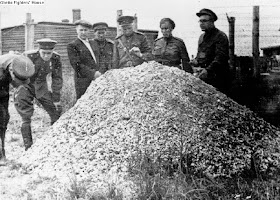 |
| Soviet soldiers inspecting a pile of human ashes, Majdanek, 1944. |
 |
| Former inmates use a dummy to demonstrate how corpses were brought to the ovens. |
 |
| A rare photo of a burning camp oven being tended. |
9. Special Execution Squads
As mentioned earlier, Einsatzgruppen were sent out to track down whoever the Party bosses wanted to be eliminated: Jews, Poles, Gypsies, whoever it was. These SS death squads generally worked alone, without the help of regular army units (though sometimes, despite the denials of many, the regular army did help - it depended upon the local commander). They were "special" detachments sent into occupied territories to cleanse the newly recovered territories of undesirables.
While the Einsatzgruppen are a truly horrible concept, the number of people they could kill was small compared to later, in the camps, when things were systematized and operated with assembly-line precision. But this killing was up close and personal.
A typical Einsatzgruppe would cover a territory, within which it would visit the towns. The Jews of a town would be identified, rounded up and brought out into a field. There, they typically would be given shovels and told to dig a huge hole. Sometimes, the hole was already dug, or it was simply a ravine that could be filled in. Then... well, the pictures show what happened then.
 |
| In mid-December, 1941, the edge of the ditch is the killing site on Skede beach, near Liepaja, Latvia. Once shot in the back of the head, the victims fall into the mass grave. |
10. Retribution
The war came to a close, and the camps were liberated. Those inmates who survived often were given a chance to exact vengeance on their tormentors. It was hardly equivalent to what had been dispensed by the guards, but it was something.
The first step was to eliminate the conceit that the locals "knew nothing," as Sergeant Schultz from "Hogan's Heroes" would say. The villagers who lived basically just down the street from the camps were brought in and shown what had been going on - as if they hadn't known all along. General Dwight D. Eisenhower thought this would be instructive, and it was one of the smarter things that he ever did. It was very difficult later to deny the facts when you saw them up close and personal and, more impressively, smelled them.
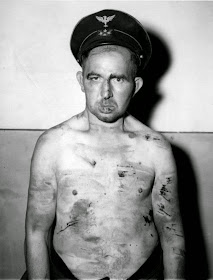 |
| The battered Mayor of the Belgian town of Olloy-sur-Viroin, captured by the Belgian Resistance group Front de l'Independance Namur (FIN), is forced to pose for a photograph following the liberation of the town. During his term in office under German occupation, he worked for the Gestapo and was responsible for the arrest of Belgian youths who were sent to labor and concentration camps. Olloy-sur-Viroin, Namur, Belgium. September 1944. |
But the retribution did not stop there. Oh, no. People took out their feelings in a quite personal fashion.
 |
| Russian slave laborer among prisoners liberated by 3rd Armored Division points out a former guard who brutally beat prisoners. Germany, April 14, 1945, possibly Mittelbau-Dora Concentration Camp, Nordhausen, Germany. |
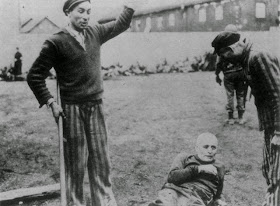 |
| I have different dates for this photo and the one above, but the German looks awfully similar. This picture apparently was taken on April 29, 1945, the day of liberation at Dachau Concentration Camp. The man on the ground is an SS guard moments away from being executed by the inmates standing near him. During his time as a guard, he brutalized and murdered untold numbers of innocent men, women, and children. Only at the point of death does he show remorse. He was executed with the shovel in the hand of the inmate on the left. An Allied soldier turns his back, refusing to intervene, while another inmate taunts him, perhaps spits on him. In the background, other SS guards, shot outright by US troops, lie along a wall. The execution drew an official inquiry that was allegedly quashed by General Eisenhower personally. |
Some concentration camp officers just disappeared upon liberation - the Americans may have just given them over to the inmates, then put the bodies in with the victims and never notified anyone of anything.
 |
| A freed Jewish prisoner expresses his rage and beats down a German guard at the liberated Dachau Concentration Camp. An American soldier looks on and does not interfere. Germany, 1945 |
That was almost certainly the case now and then. But that's just supposition, nobody kept records of any such occurrences.
 |
| One of the first punishments for the SS prison guards was to force them to load victims of Bergen-Belsen concentration camp into trucks for burial in mass graves. Note the British troops in the background with Sten submachine gun and Lee-Enfield rifles. The photo was taken on April 17, 1945, in Germany. |
There were many female concentration camp guards, presumably to tend to the female prisoners (but not always). They were not given leniency. Anyone who assumes that women are automatically kinder and more compassionate than men when in a position of ultimate power should look up Ilse Koch and Jenny Wanda Barkmann and think about it.
 |
| SS Guard at Buchenwald, April 1945. |
Usually, there weren't any trials. The guard was taken to a wall, stood up, and shot without any formality. Or, perhaps the GIs let the released inmates do whatever they liked to them, in which case the guards would probably wish they had been shot outright. The guards' families were left to wonder what happened to them, just as with all the people taken away without notice under Nacht und Nebel, some of whose bones the now-dead camp guards joined.
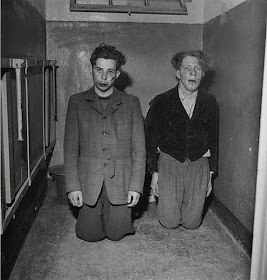 |
| These are Buchenwald concentration camp guards who received a beating from the prisoners when the camp was liberated by the Americans. The picture was taken in April 1945, by the U.S. military photographer Elizabeth Miller. |
 |
| Unknown Buchenwald concentration camp guard, beaten and hanged by the prisoners upon the liberation of the camp. The picture was taken by the American military photographer Elizabeth Miller. |
 |
| Ilse Koch, Witch of Buchenwald. |
 |
| Prison camp guards executed at Dachau by US GIs. |
 |
| Many, many people were completely messed up by the Holocaust, and this lasted for years, decades... forever. Peter Chemy, a Polish national liberated from a concentration camp in May 1945, spent the first few months of his freedom adrift in Germany. [H]e found refuge in the home of a German family: husband, wife, and daughter. After they had gone to sleep, Chemy found a hatchet and murdered them in their beds. He was tried by an American tribunal, sent to Landsberg, and executed by firing squad in January 1947. [Source: Williams, Lt. Joseph H; Captor-Captive, Jacksonville, Girtman Press, 1986.] |
11. Escape
Some Jews escaped before the Holocaust in the 1930s, some escaped after. Nobody really wanted to stick around, one way or the other. Very few escaped from concentration camps themselves, though it happened now and then. That's one reason the camps were such a surprise to the Allies upon the invasion of Germany.
 |
| Jewish refugees aboard St Louis, 1939. Some refugees made it - and some ships were turned back. It's not as if the whole world was anxiously awaiting shiploads of Jewish immigrants. |
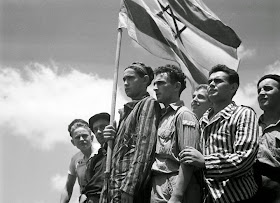 |
| Jewish survivors of Buchenwald arrive in Haifa, 1945. An extremely uncertain future awaits, but they sure weren't staying in Germany. |
12. Liberation
 |
| The liberation of Dachau. This picture looks perfect - perhaps a touch too perfect. The Americans had a tendency to stage some of these 'liberation' shots shortly after the real thing, when you wouldn't have had the huge crowds and arms upraised and all that. If you look carefully, you can spot quite a few people looking up at the camera. But, it does capture the spirit of the event. Somewhat ironically, this appears to have been taken from a guard tower. |
The Allies had plenty of information about the death camps well before their liberation from several different sources. They even intentionally placed at least one agent inside of a camp, who escaped and gave a full report. However, the grunts in the field certainly did not know what to expect, and they rightly were horrified by what they found.
The Germans were still fighting, and there were still (incredibly) guards at the camps who did not have the good sense to scram as the Allies approached. Those who remained until the camp was captured lived to regret it - though often not much longer than that.
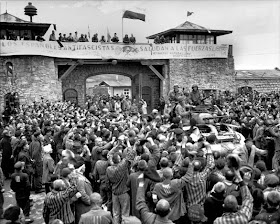 |
| Mauthausen, Austria, The camp inmates welcoming the US Army, 06/05/1945. The soldiers are from the 65 Infantry Division of the US Army. The soldier on the tank, on the left, is Maurice Handelman, a Jewish soldier in a patrol unit, who was the first to open the camp gates and enter it on that day. According to P. Serge Choumoff, a historian and survivor of Mauthausen, this event was recreated one day after the actual liberation, at the request of General Eisenhower. |
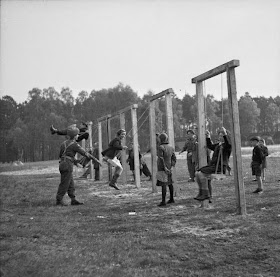 |
| Liberators pushing liberated concentration camp inmates on swings. Outwardly, life returned to normal, but for many, the emotional scars never left. |
 |
| Bergen Belsen, Germany, Survivors, and liberators watching the camp burning, after liberation, May 1945. British soldiers hung a photograph of Hitler on barrack 44 before setting it on fire. He was already dead, and they were alive. A small victory. |
13. Dead Bodies
It may seem redundant - dead bodies at an extermination camp - but in fact, the camps were kept very neat and tidy until the very end. Himmler would inspect them personally. They had to be in order or, you know, he might get upset or something.
Liberation or no liberation, the dead bodies remained. The camps were full of dead bodies when the Americans and Russian arrived, which actually was not the normal state of affairs at the camps. The Germans had organized the system so that dead bodies were quickly burned or buried. However, epidemics broke out in the closing days, and food ran out or wasn't dispensed to incarcerated inmates, causing sudden mass starvation to already deprived prisoners. The German defendants at Nuremberg attempted to use that as some kind of justification for the deaths, but that argument went nowhere.
Plus, the Germans killed as many inmates as they could right before liberation, and they couldn't all be disposed of in time. Thus, there was an unusually large disposal problem upon liberation, which the liberators happily had the former German concentration camp guards help with before prosecuting or simply hanging them outright.
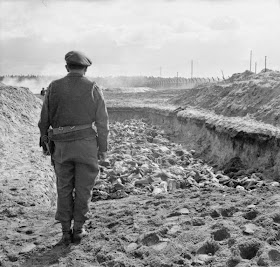 |
| A British Army chaplain holds a service over a massed grave before it is filled in at Bergen-Belsen |
14. A Day at the Movies
General George Patton was in charge of the US Third Army that liberated many of the concentration camps in Southern Germany. He had this to say about the Holocaust, with remarkable foresight:
"Document everything, leave nothing to chance... because one day, some cockroach will crawl up out of the latrine and deny all this ever happened, Damn Them." - Gen. George Patton, spoken during visit to Buchenwald.
The documentation that the General spoke of came in handy very quickly, at the Nuremberg trials held during the late 1940s. However, it has had continuing usefulness down through the years, both as a way to remember what occurred and as an educational tool for those who, well, needed an education.
German soldiers, in an American prison, were forced to watch a film of a German concentration camp. The same films helped convict the German leaders at the Nuremberg trials. These fellows were lucky; the Soviets would not have bothered to show them the films. Instead, they would simply have mistreated them until 95% were dead, with the rest released with no job, no home and no future.
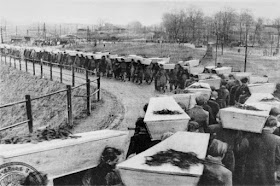 |
| Picture of the funeral for inmates of Auschwitz who could not be saved or were killed by the SS as the liberating Soviet army approached. |
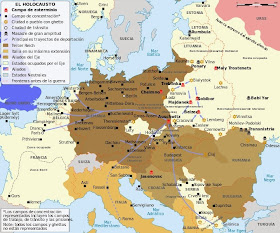 |
| Map of the Holocaust in Europe during World War II, 1939-1945. This map shows all extermination camps (or death camps), most major concentration camps, labor camps, prison camps, ghettos, major deportation routes, and major massacre sites. Did you know that there was a concentration camp directly across from England? |
2020




































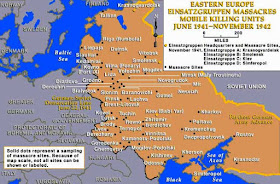



























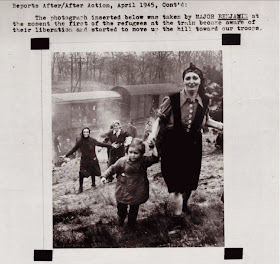


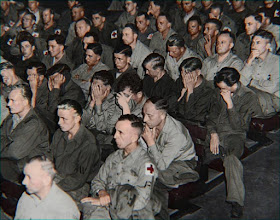

An excellent piece. In relation to the women having their hair removed, it was used to fill crewmen's mattresses' in submarines. The sad thing now is the amount of people and some cultures who deny that the Holocaust ever happened.
ReplyDeleteThanks! This was a tough article to write, because it is such an immense subject with so much material. I wanted to give a complete outline of the major points, and I hope I did that. I did not know about the way they used the hair, but I believe it. The whole use of human body parts for ordinary activities is so revolting it is difficult to even think about. I have seen some argue that the use of human skin to make lampshades is a myth, and that it actually was some other material such as goat skin. There is so much other material to use to show how horrible the Holocaust was, though, that there's no need to emphasize anything beyond the basic, indisputable facts.
DeleteI'm Russian whose family suffered a lot during the ww2. One uncle was a prisoner of war liberated by the British army. He told us later he was lucky that the Brits sent him to the American sector. Brits, according to him, viewed POWs as traitors, while Americans did not treat anybody too harshly. One phrase in your narrative about the Russians wouldn't spare the prisoners of war lives reminded me a story our neighbors in Leningrad told us after the war. She survived the Siege of Leningrad. After the blockade was lifted many German POWs were brought to the city to clear bombed out buildings sites.. She was passing by when she noticed a young kid, almost a child, thin and shivering. She felt so sorry for the poor kid - she took him to her kitchen and gave him two hot potatoes she was boiling. The kid looked at her with teary eyes and said in broken Russian, "Please, add more!" She didn't have much left, but she added one more potato.. The kid tried to cover with his hand the cantine, but again repeated the same words. Finally she understood that the guards, probably, were playing a joke teaching him wrong words instead of "Thank you".. But another neighbor was a different story.. He was a scout in the Army, and one day he entered a village just minutes after the Germans left it. The village was empty. He found all people in a large well, stuffed in alive.. Children, men, women, elderly. He said he'd never took a prisoner from that point on... Can you blame him?
ReplyDeleteI am so sorry,that I find it so impossible to comment.I was born in 1940.I have seen pictures all my life of the horror and i still get so upset and angry when I see them.Man's inhumanity to Man astounds me to this day.I only hope they make this information available to school children of today and teach them the horrors of war.
ReplyDeleteI've been angry for a long time. My mother was "procured (that's what was on the rolodex card we got from the UN Refugee division. by the Germans when she was 18,was a slave laborer at a farm and then was a slave laborer in Ravensbruck concentration camp. She was forced to work at the Siemens plant in the camp. I have never,and will never buy a siemens product. And we are supposed to feel sorry for the treatment the Germans got after the war ?
DeleteI have no words. None are fitting for the horror of this. I have been studying the Holocaust and photos of that time makes me sick to my stomach. It’s the reality of the evil in this world.
ReplyDeleteI have written two books for young adults about the Holocaust so that young people will never forget. I self published and have distributed the books myself. I hope ine day to find a publisher who will help me spread the story further.
ReplyDelete